否定句型J
几种否定形式表示肯定意义的特殊句型
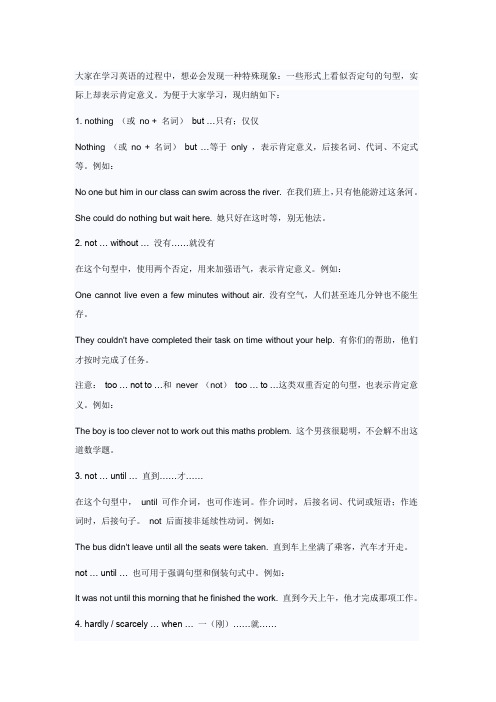
大家在学习英语的过程中,想必会发现一种特殊现象:一些形式上看似否定句的句型,实际上却表示肯定意义。
为便于大家学习,现归纳如下:1. nothing (或no + 名词)but …只有;仅仅Nothing (或no + 名词)but …等于only ,表示肯定意义,后接名词、代词、不定式等。
例如:No one but him in our class can swim across the river. 在我们班上,只有他能游过这条河。
She could do nothing but wait here. 她只好在这时等,别无他法。
2. not … without … 没有……就没有在这个句型中,使用两个否定,用来加强语气,表示肯定意义。
例如:One cannot live even a few minutes without air. 没有空气,人们甚至连几分钟也不能生存。
They couldn't have completed their task on time without your help. 有你们的帮助,他们才按时完成了任务。
注意:too … not to …和never (not)too … to …这类双重否定的句型,也表示肯定意义。
例如:The boy is too clever not to work out this maths problem. 这个男孩很聪明,不会解不出这道数学题。
3. not … until … 直到……才……在这个句型中,until 可作介词,也可作连词。
作介词时,后接名词、代词或短语;作连词时,后接句子。
not 后面接非延续性动词。
例如:The bus didn't leave until all the seats were taken. 直到车上坐满了乘客,汽车才开走。
not … until … 也可用于强调句型和倒装句式中。
否定句型

否定句型I am not ...结构︰主词+be 动词(am/are/is)+not+…。
说明︰在肯定句中be <动词>的后面加not 就构成<否定句>。
I am not a student. 我不是学生。
You are not a lawyer. 你不是律师。
It is not a watch. 它不是手表。
I am not + V-ing.结构︰主词+am(are/is)+not+现在分词…。
说明︰此句型意为“<主词>(人,物)不是正在…”。
要构成<现在进行式>的<否定句>,只需在be <动词>后面加not。
They are not playing. 他们不是正在玩。
She is not watching TV. 她不是正在看电视。
We are not cleaning the room. 我们不是正在打扫房间。
I don’t + V ...结构︰主词+don’t/doesn’t+原形动词+…。
说明︰此句型意为“<主词>不(没有)做某事”。
肯定句中,如有一般<动词>(speak/work/teach/…),则在一般<动词>前加don’t 或doesn’t,并将一般<动词>改为原形<动词>(不加s或es),即构成<否定句>。
I don’t have any brothers.我没有任何的兄弟。
He doesn’t know Mr. Brown.他不认识布朗先生。
My mother doesn’t speak English.我母亲不会讲英语。
I wasn’t ...结构︰主词+was/were+not+形容词+过去时间。
说明︰此句型意为“<主词>不是…”。
was,were 是be 动词的<过去式>,当句中出现以下<副词>(<片语>)时,<动词>常用过去式:ago,before,yesterday(morning,afternoon,evening),last night,the other day,in the past,just now…。
高中英语双重否定句的几种常见句型

英语双重否定句的几种常见句型英语句子中常可见到两个表示否定意义的词连用的情况,这一现象常称为双重否定。
这种句子形式上虽为否定,实则表示强烈的肯定语气。
英语双重否定句常见的有如下三种句型:1、否定词no/not等+表示否定意义的形容词。
例如:He has no small reputation as a scientist.他是名气很大的科学家。
No way is impossible to courage.勇士面前无险路。
It is not uncommon for students to have friendly relationship with their teachers.学生与老师建立友好关系并不罕见。
It is conflict and not unquestioning agreement that keeps freedom alive.使自由保持活力的是冲突而不是绝对的一致。
Nothing is unnecessary.没有什么是不必要的。
2、否定词no/not/never等+without…No smoke without fire·[proverb][谚]无火不起烟;无风不起浪。
We cannot succeed without your help.没有你们的帮助,我们就不能成功。
They never meet without quarreling.他们每次见面必吵架。
Nothing to be got without pains but poverty.[proverb][谚]只有贫穷是可以不劳而获的。
3、否定词no/not/never/nobody/few等+具有否定意义的动词或短语。
There is no denying the truth.真理是不能否认的。
The tart reply did not discomfort him.那尖刻的回答并没有使他难过。
英语听力否定意义的句型结构

英语听力否定意义的句型结构
否定意义的句型结构导语:2014高考最后冲刺阶段到了,英语听力作为高考英语试卷中比较容易得分的一部分,在这时更应该巩固知识,
做到会的绝不丢分,小编为考生们整理了场景词汇的作用,希望大家
查漏补缺,取得好成绩。
含否定意义的句型结构主要有:
(1)tooto 太以至不能
(2)sothat (as to)+否定词如此以至(不能)
(3)It is impossible to 是不可能的
(4)the last+名词+动词不定式(或从句) 极少可能的,最不合适的
(5)Never before+(倒装语序) 从来没有
【例20】
Are you sure youre speaking the truth? It sounds too good to be true.
你肯定讲的是真话吗?听起来太妙了,简直令人难以相信。
【例21】
He was so excited as to forget most what he meant to say.
他太激动了,竟把原来要讲的话大多忘记了。
【例22】
He is the last man I want to see.
他是我最不想见的人。
【例23】
Never before have I heard Mr. Wang sing such beautiful songs.
我从来没有听到王先生唱出如此动听的歌。
【例24】
It is impossible for him to write out such good composition.
对他来说写出这样好的文章是不可能的。
否定句的结构和常见句型
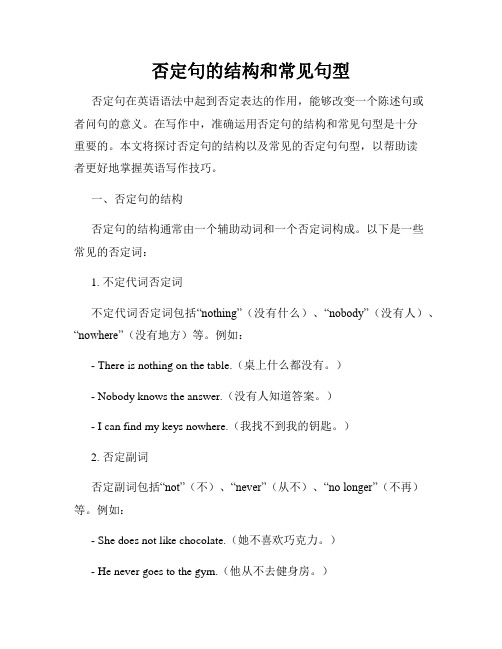
否定句的结构和常见句型否定句在英语语法中起到否定表达的作用,能够改变一个陈述句或者问句的意义。
在写作中,准确运用否定句的结构和常见句型是十分重要的。
本文将探讨否定句的结构以及常见的否定句句型,以帮助读者更好地掌握英语写作技巧。
一、否定句的结构否定句的结构通常由一个辅助动词和一个否定词构成。
以下是一些常见的否定词:1. 不定代词否定词不定代词否定词包括“nothing”(没有什么)、“nobody”(没有人)、“nowhere”(没有地方)等。
例如:- There is nothing on the table.(桌上什么都没有。
)- Nobody knows the answer.(没有人知道答案。
)- I can find my keys nowhere.(我找不到我的钥匙。
)2. 否定副词否定副词包括“not”(不)、“never”(从不)、“no longer”(不再)等。
例如:- She does not like chocolate.(她不喜欢巧克力。
)- He never goes to the gym.(他从不去健身房。
)- I am no longer interested in that book.(我对那本书不再感兴趣。
)3. 否定形容词否定形容词包括“unhappy”(不快乐)、“inhospitable”(不好客)、“impossible”(不可能)等。
例如:- The little girl is unhappy about the news.(小女孩对这个消息感到不开心。
)- The hotel staff were inhospitable to us.(酒店员工对我们不友好。
)- It is impossible to finish the task in such a short time.(在这么短的时间内完成任务是不可能的。
)二、常见句型1. 否定陈述句否定陈述句与肯定陈述句在结构上基本相同,只是在谓语动词前添加否定词。
否定句句型结构

否定句句型结构一、什么是否定句句型结构在语法中,否定句是指对某种陈述或命题的否定,即表示否定的句子。
否定句句型结构是指通过特定的语法结构构成的否定句。
1. 否定副词+谓语动词例句:我不喜欢吃苹果。
解析:不是表示否定的副词,放在谓语动词前面,构成否定句。
2. 谓语动词+否定副词例句:他喜欢不吃苹果。
解析:表示否定的副词放在谓语动词后面,构成否定句。
3. 谓语动词+不+动词例句:她不会游泳。
解析:表示否定的副词"不"放在谓语动词前面,再加上动词,构成否定句。
4. 谓语动词+没有+名词/动词的过去分词例句:我没有吃午饭。
解析:表示否定的副词"没有"放在谓语动词前面,再加上名词或动词的过去分词,构成否定句。
5. 谓语动词+没有+动词的不定式例句:我们没有去游泳。
解析:表示否定的副词"没有"放在谓语动词前面,再加上动词的不定式,构成否定句。
6. 谓语动词+没+动词的不定式例句:他没看见我。
解析:表示否定的副词"没"放在谓语动词前面,再加上动词的不定式,构成否定句。
7. 谓语动词+不+形容词/副词例句:这个问题不容易解决。
解析:表示否定的副词"不"放在谓语动词前面,再加上形容词或副词,构成否定句。
8. 谓语动词+不+名词例句:她不是医生。
解析:表示否定的副词"不"放在谓语动词前面,再加上名词,构成否定句。
9. 谓语动词+没有+名词例句:他没有工作。
解析:表示否定的副词"没有"放在谓语动词前面,再加上名词,构成否定句。
10. 谓语动词+不+助词+动词例句:他不会说英语。
解析:表示否定的副词"不"放在谓语动词前面,再加上助词和动词,构成否定句。
三、总结以上是否定句句型结构的分类,通过不同的语法结构可以构成不同形式的否定句。
在表达否定的句子时,我们可以根据具体的情境和需要选择合适的句型结构。
句型宝典否定句型1
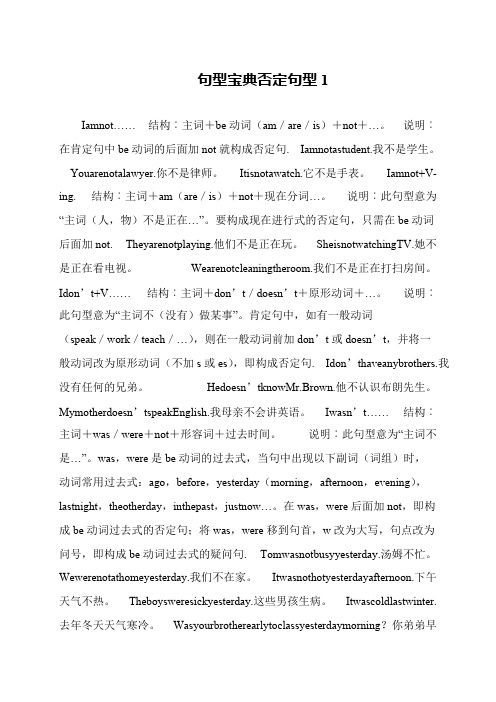
句型宝典否定句型1Iamnot…… 结构︰主词+be动词(am/are/is)+not+…。
说明︰在肯定句中be动词的后面加not就构成否定句. Iamnotastudent.我不是学生。
Youarenotalawyer.你不是律师。
Itisnotawatch.它不是手表。
Iamnot+V-ing. 结构︰主词+am(are/is)+not+现在分词…。
说明︰此句型意为“主词(人,物)不是正在…”。
要构成现在进行式的否定句,只需在be动词后面加not. Theyarenotplaying.他们不是正在玩。
SheisnotwatchingTV.她不是正在看电视。
Wearenotcleaningtheroom.我们不是正在打扫房间。
Idon’t+V…… 结构︰主词+don’t/doesn’t+原形动词+…。
说明︰此句型意为“主词不(没有)做某事”。
肯定句中,如有一般动词(speak/work/teach/…),则在一般动词前加don’t或doesn’t,并将一般动词改为原形动词(不加s或es),即构成否定句. Idon’thaveanybrothers.我没有任何的兄弟。
Hedoesn’tknowMr.Brown.他不认识布朗先生。
Mymotherdoesn’tspeakEnglish.我母亲不会讲英语。
Iwasn’t…… 结构︰主词+was/were+not+形容词+过去时间。
说明︰此句型意为“主词不是…”。
was,were是be动词的过去式,当句中出现以下副词(词组)时,动词常用过去式:ago,before,yesterday(morning,afternoon,evening),lastnight,theotherday,inthepast,justnow…。
在was,were后面加not,即构成be动词过去式的否定句;将was,were移到句首,w改为大写,句点改为问号,即构成be动词过去式的疑问句. Tomwasnotbusyyesterday.汤姆不忙。
否定句的句型

否定句的句型否定句可以通过在句子中使用否定词或词组来表达否定的意思。
以下是几种常见的否定句句型:1. 主语+ 动词+ not + 其他成分例如:- I do not like chocolate.(我不喜欢巧克力。
)- They are not coming to the party.(他们不来参加派对。
)2. 主语+ 助动词+ not + 动词+ 其他成分例如:- She cannot swim.(她不会游泳。
)- We did not finish the project.(我们没有完成这个项目。
)3. 主语+ be动词+ not + 其他成分例如:- He is not happy.(他不开心。
)- The book is not on the shelf.(书不在书架上。
)4. 主语+ do/does/did + not + 动词原形+ 其他成分例如:- We do not eat meat.(我们不吃肉。
)- Did you not see the movie?(你没有看到那部电影吗?)5. 主语+ have/has/had + not + 过去分词/动词原形+ 其他成分例如:- She has not visited Paris.(她没有去过巴黎。
)- They had not finished their homework.(他们没有完成他们的作业。
)6. 主语+ cannot/may not/must not/should not + 动词原形+ 其他成分例如:- You cannot enter without a ticket.(没有票你不能进入。
)- We must not forget to lock the door.(我们不能忘记锁门。
)7. 主语+ 动词+ never/rarely/hardly/scarcely + 动词的副词形式+ 其他成分例如:- She never goes to bed early.(她从不早睡。
英语双重否定句的几种常见句型

英语双重否定句的几种常见句型英语句子中常可见到两个表示否定意义的词连用的情况,这一现象常称为双重否定。
这种句子形式上虽为否定,实则表示强烈的肯定语气。
英语双重否定句常见的有如下三种句型:1、否定词no/not等+表示否定意义的形容词。
例如:He has no small reputation as a scientist.他是名气很大的科学家。
No way is impossible to courage.勇士面前无险路。
It is not uncommon for students to have friendly relationship with their teachers.学生与老师建立友好关系并不罕见。
It is conflict and not unquestioning agreement that keeps freedom alive.使自由保持活力的是冲突而不是绝对的一致。
Nothing is unnecessary.没有什么是不必要的。
without……2、否定词no/not/never等+withoutNo smoke without fire·[proverb][谚]无火不起烟;无风不起浪。
We cannot succeed without your help.没有你们的帮助,我们就不能成功。
They never meet without quarreling.他们每次见面必吵架。
Nothing to be got without pains but poverty.[proverb][谚]只有贫穷是可以不劳而获的。
3、否定词no/not/never/nobody/few等+具有否定意义的动词或短语。
There is no denying the truth.真理是不能否认的。
The tart reply did not discomfort him.那尖刻的回答并没有使他难过。
否定句型英语
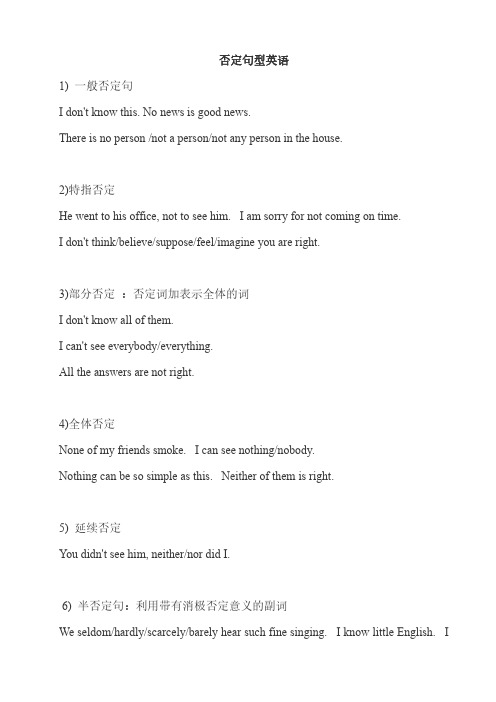
否定句型英语1)一般否定句I don't know this.No news is good news.There is no person/not a person/not any person in the house.2)特指否定He went to his office,not to see him.I am sorry for not coming on time.I don't think/believe/suppose/feel/imagine you are right.3)部分否定:否定词加表示全体的词I don't know all of them.I can't see everybody/everything.All the answers are not right.4)全体否定None of my friends smoke.I can see nothing/nobody.Nothing can be so simple as this.Neither of them is right.5)延续否定You didn't see him,neither/nor did I.6)半否定句:利用带有消极否定意义的副词We seldom/hardly/scarcely/barely hear such fine singing.I know little English.Isaw few people.7)双重否定:双重否定相当于肯定You can't make something out of nothing.What's done cannot be undone.No gain without pains.No man is so old but(that)he can learn.8)排除否定Everyone is ready except you.He did nothing but play. But for your help,I couldn't do it.9)加强否定:利用否定词来加强语气I won't do it at all.。
一般过去时的被动语态的否定形式句型结构

一般过去时的被动语态的否定形式句型结构一般过去时的被动语态是表示过去某个动作或事件对主语的影响或作用的一种语态形式。
在句子中,被动语态的动作发出者常常不明确或不重要,而强调的是动作的承受者或受影响者。
下面列举了10个以一般过去时的被动语态的否定形式的句型结构。
1. The books were not returned on time.这些书没有按时归还。
2. The car was not repaired yesterday.昨天汽车没有修好。
3. The cake was not baked properly.蛋糕没有烤好。
4. The report was not submitted to the manager.报告没有提交给经理。
5. The meeting was not canceled.会议没有被取消。
6. The room was not cleaned yesterday.昨天房间没有被打扫。
7. The news was not announced to the public.这个消息没有对公众宣布。
8. The project was not completed on time.这个项目没有按时完成。
9. The email was not sent successfully.邮件没有成功发送。
10. The message was not delivered to the recipient.这条消息没有被送达给收件人。
以上是以一般过去时的被动语态的否定形式句型结构的例子。
被动语态的使用可以强调动作的承受者或受影响者,而不关注动作的执行者。
在写作中,使用被动语态可以使句子更加丰富,变化更加多样化。
然而,需要注意的是,在使用被动语态时,要确保句子的逻辑清晰,语意明确,避免歧义或错误信息的出现。
英语否定句型

外教一对一英语否定句型1. all 的否定式:not all... / all...not表示“并非都……”“不是所有的都……”。
如:Not all men can be masters.=All men cannot be masters.并非人人都能当头头。
Not all bamboo grows tall.并非所有的竹子都会长得很高。
2. both 的否定式:not...both / both...not 表示“并非两个……都……”。
如:I don't want both the books. 我不是两本书都要。
Both (the) windows are not open. 两扇窗子并不都开着。
3. every...的否定式:表示“不是每……都……”。
如:Not every book is educative.=Every book is not educative.不是每本书都有教育意义的。
Not everyone likes this book. 并非人人都喜欢这本书。
This flower is not seen everywhere.这花并不是随处可见的。
4. always的否定式:表示“并非总是 / 并非一直……”。
如:He is not always so sad. 他并不是一直都这样悲伤。
5. entirely,altogether,completely 和quite 的否定式:外教一对一 表示“不完全……”“并非完全……”。
如:The businessman is never to be entirely trusted.不可以完全信任商人。
He felt not altogether satisfied. 他并不完全满意。
I don't agree completely. 我并不完全同意。
What he did was not quite proper. 他做的事不十分妥当。
否定句句型
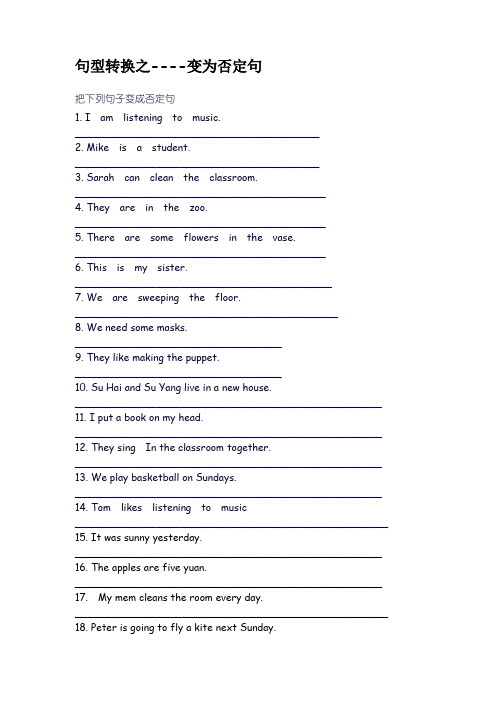
句型转换之----变为否定句把下列句子变成否定句1. I am listening to music._______________________________________2. Mike is a student._______________________________________3. Sarah can clean the classroom.________________________________________4. They are in the zoo.________________________________________5. There are some flowers in the vase.________________________________________6. This is my sister._________________________________________7. We are sweeping the floor.__________________________________________8. We need some masks._________________________________9. They like making the puppet._________________________________10. Su Hai and Su Yang live in a new house._________________________________________________ 11. I put a book on my head._________________________________________________ 12. They sing In the classroom together._________________________________________________ 13. We play basketball on Sundays._________________________________________________ 14. Tom likes listening to music__________________________________________________ 15. It was sunny yesterday._________________________________________________ 16. The apples are five yuan._________________________________________________ 17. My mem cleans the room every day.__________________________________________________ 18. Peter is going to fly a kite next Sunday.__________________________________________________ 19. My bag is red._____________________________________________20. This shirt is very nice.______________________________________________21. He`s going to the Great Wall._______________________________________________22. It is an elephant.______________________________________________23. He takes some pictures every day.______________________________________________________ 24. It’s cheap enough.______________________________________________________ 25. The teacher should make the students happy every day.______________________________________________________ 26.Show me your library card,please.______________________________________________________ 27. She gave her brother some tapes about folk music.______________________________________________________ 28. This is the first time we come to Australia.______________________________________________________ 29. We’d better make a shopping list first.______________________________________________________ 30. There are a lot of(大量的)lovely animals there.______________________________________________________ 31. My mother will take me to Beijing for my holiday next Sunday.______________________________________________________ 32. You can find many tall trees in the picture of the park._________________________________________33. The girl is singing in the classroom.______________________________________________34. The waiter and the waitress play table tennis every day.________________________________________________35. He does well in Maths._______________________________________________36. Turn right at the third crossing._________________________________________________37. Please turn off the light.___________________________________________________ 38. The boy can jump higher than the girl.___________________________________________________ 39. Mum is going to buy me a new bike.___________________________________________________ 40. Put the shoes near the cupboard.___________________________________________________。
否定句的句型结构
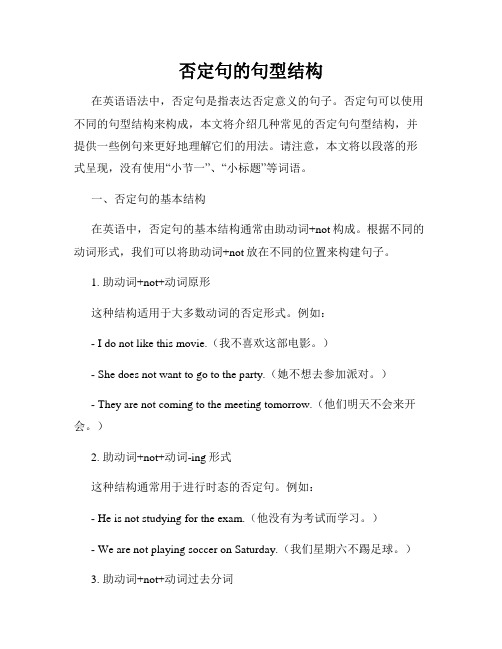
否定句的句型结构在英语语法中,否定句是指表达否定意义的句子。
否定句可以使用不同的句型结构来构成,本文将介绍几种常见的否定句句型结构,并提供一些例句来更好地理解它们的用法。
请注意,本文将以段落的形式呈现,没有使用“小节一”、“小标题”等词语。
一、否定句的基本结构在英语中,否定句的基本结构通常由助动词+not构成。
根据不同的动词形式,我们可以将助动词+not放在不同的位置来构建句子。
1. 助动词+not+动词原形这种结构适用于大多数动词的否定形式。
例如:- I do not like this movie.(我不喜欢这部电影。
)- She does not want to go to the party.(她不想去参加派对。
)- They are not coming to the meeting tomorrow.(他们明天不会来开会。
)2. 助动词+not+动词-ing形式这种结构通常用于进行时态的否定句。
例如:- He is not studying for the exam.(他没有为考试而学习。
)- We are not playing soccer on Saturday.(我们星期六不踢足球。
)3. 助动词+not+动词过去分词这种结构通常用于完成时态的否定句。
例如:- The book has not been read by many people.(这本书没有被很多人阅读过。
)- They have not finished the project yet.(他们还没有完成这个项目。
)二、特殊句型的否定结构除了基本的否定句结构外,还有一些特殊的句型也可以用来表达否定意义。
1. There is/are/was/were+not+名词这种结构用于表示存在否定,通常用于陈述句或疑问句中。
例如:- There is not a cloud in the sky.(天空中没有一片云。
)- Were there not any tickets left for the concert?(演唱会的票没有剩下吗?)2. Neither/nor+主语+助动词+谓语这种结构用于表示两个否定选择中的否定。
英语否定句句型
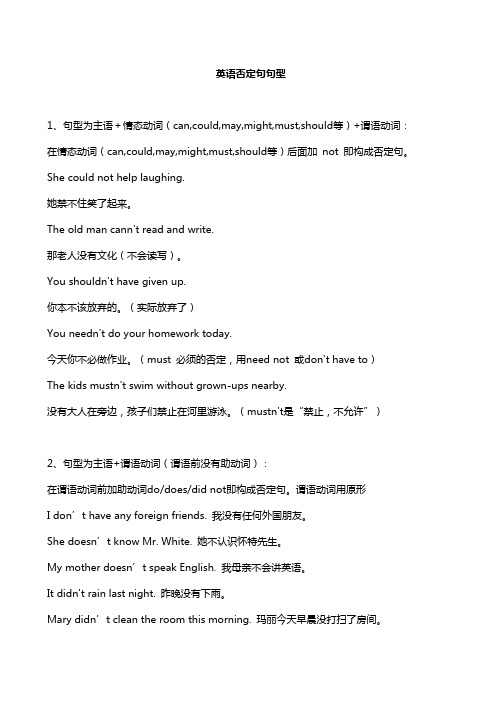
英语否定句句型1、句型为主语+情态动词(can,could,may,might,must,should等)+谓语动词:在情态动词(can,could,may,might,must,should等)后面加not 即构成否定句。
She could not help laughing.她禁不住笑了起来。
The old man cann't read and write.那老人没有文化(不会读写)。
You shouldn't have given up.你本不该放弃的。
(实际放弃了)You needn't do your homework today.今天你不必做作业。
(must 必须的否定,用need not 或don't have to)The kids mustn't swim without grown-ups nearby.没有大人在旁边,孩子们禁止在河里游泳。
(mustn't是“禁止,不允许”)2、句型为主语+谓语动词(谓语前没有助动词):在谓语动词前加助动词do/does/did not即构成否定句。
谓语动词用原形I don’t have any foreign friends. 我没有任何外国朋友。
She doesn’t know Mr. White. 她不认识怀特先生。
My mother doesn’t speak English. 我母亲不会讲英语。
It didn't rain last night. 昨晚没有下雨。
Mary didn’t clean the room this morning. 玛丽今天早晨没打扫了房间。
John didn’t get up early this morning. 约翰今天早晨没有早起床。
Do not swicth off (祈使句的否定)。
14章用于否定的句型
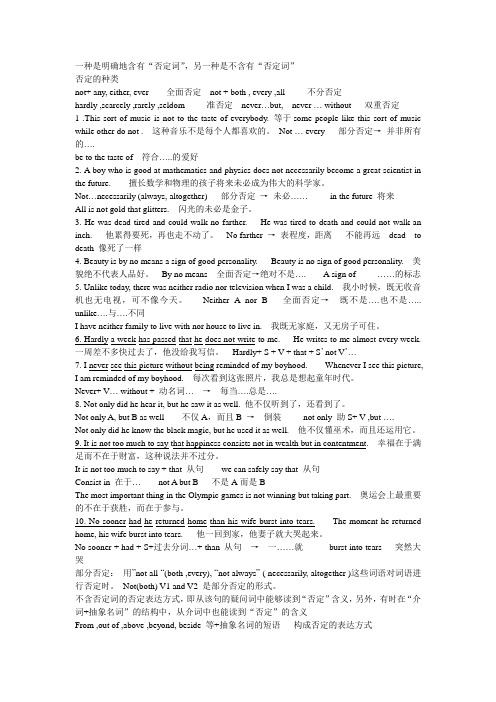
一种是明确地含有“否定词”,另一种是不含有“否定词”否定的种类not+ any, either, ever 全面否定not + both , every ,all 不分否定hardly ,scarcely ,rarely ,seldom 准否定never…but, never … without 双重否定1 .This sort of music is not to the taste of everybody. 等于some people like this sort of music while other do not . 这种音乐不是每个人都喜欢的。
Not … every 部分否定→并非所有的….be to the taste of 符合…..的爱好2. A boy who is good at mathematics and physics does not necessarily become a great scientist in the future. 擅长数学和物理的孩子将来未必成为伟大的科学家。
Not…necessarily (always, altogether) 部分否定→未必……in the future 将来All is not gold that glitters. 闪光的未必是金子。
3. He was dead tired and could walk no farther. He was tired to death and could not walk an inch. 他累得要死,再也走不动了。
No farther →表程度,距离不能再远dead to death 像死了一样4. Beauty is by no means a sign of good personality. Beauty is no sign of good personality. 美貌绝不代表人品好。
否定、否定句和否定句型刍议

否定、否定句和否定句型刍议文章首先从理论上论证了否定可以分为形式的否定和内容的否定,进而将否定句分为广义和狭义两种:广义的指所有包含了否定形式或者表达了否定内容的句子,狭义的专指表达否定判断的句子。
在此基础上,结合已有句型统计的实践,文章认为在句型系统中,单句应该先划分为肯定句和否定句。
标签:否定;形式否定;内容否定;否定句;否定句型“肯定/否定是语法中一个十分重要的范畴,许多语法现象都跟肯定否定有关。
”[1]在一般的语法讨论中,讨论的主要是跟肯定相关的问题,或者说,是默认在肯定语境下讨论问题。
而本文想讨论与肯定相对的否定问题,着重讨论跟否定有关的三个基本问题:否定、否定句和否定句型。
一、否定否定就是“否认事物的存在或事物的真实性”[2]396,就是不承认有某个事物。
因此否定是人的一种主观认识。
这种主观认识在心理世界里形成了负概念(否定概念),负判断(否定判断)等,然后反映到语言上,就形成了所谓否定词、否定句、负命题(否定命题)等。
那么这种在心理世界形成的负概念、负判断与反映它们的语言形式是否保持一致呢?通过下面的分析,我们可以看到,答案是否定的。
从“否定”的释义不难看出,被“否认”的事物本身也可以是一个负概念或负判断,就如双重否定一样,可以对否定的事物进行否定(在哲学上也有否定之否定的说法)。
因此,本来“否定”就其本义来说,应该是就内容而言的,但是由于“对否定的事物进行否定”得到的是“肯定”。
这样一来,内容和形式就会发生矛盾,或者说不一致。
因此否定首先可以分为内容的否定和形式的否定两种,或者说我们首先要区分否定的内容和否定的形式,不能笼统地谈否定。
在谈到否定时,需要明确是指否定的内容还是指否定的形式。
下面对此再做进一步的阐述。
(一)内容的否定内容的否定,指的是从内容上表达了否定的意思,即一个语言表达式表达了说话人“否认”某个事物的意思。
内容的否定当然可以采用否定的形式,即否定的语言表达式;也可以采用肯定的形式,即肯定的语言表达式。
同级比较句型否定句

同级比较句型否定句
1. 他跑得不比乌龟快多少,感觉就像被胶水黏住了脚似的。
2. 这朵花不比那根草鲜艳到哪去,都像蒙了一层灰扑扑的纱。
3. 小李的力气不比小猫大几分,拎个小袋子都好似要累瘫。
4. 她的歌声不比乌鸦叫好听多少,一开口简直像锯子锯木头。
5. 这道菜不比隔夜的剩菜可口,吃起来就像在嚼干草。
6. 他的脑子不比石头灵光,遇到问题就像个没头的苍蝇乱撞。
7. 小王的弹跳不比蜗牛强啥,跳起来就像脚底抹了胶水只离开地面一丁点儿。
8. 她的绘画水平不比三岁小孩高多少,画个人就像歪歪扭扭的火柴棍凑的。
9. 那辆车跑得不比蜗牛爬行快多少,在路上蠕动着像个巨大的铁盒子在耍赖。
10. 他的视力不比盲人好多少,看东西就像隔着一层浓雾。
11. 小张的口才不比哑巴强多少,一说话就像嘴里含着棉花。
12. 这台电脑的速度不比蜗牛散步快,打开个文件像等了一个世纪。
13. 她的时尚感不比原始人好多少,穿衣服就像胡乱把布裹在身上。
14. 他的游泳技术不比秤砣强,一下水就像石头直往下沉。
15. 这个手机的信号不比深山老林里的对讲机好,时有时无像捉迷藏。
16. 他的方向感不比无头苍蝇强,在城市里走就像在迷宫里乱撞的老鼠。
17. 那座小房子不比狗窝大多少,进去就像被塞进了火柴盒。
18. 他的酒量不比小蚂蚁能喝多少,沾一点酒就像被风吹倒的小草。
【初中英语】六种带有否定词的比较句型

【初中英语】六种带有否定词的比较句型英语中表示比较的句型相当多,如果句型中插进了一个否定词,其意义和用法就很难掌握,下面介绍几种常见的表达方式:1.不优于:意思是“与……相同”;实际上等于,例如:eg.heisnobetterthanabeggar.他实际上是个乞丐。
eg.theinvalidisnobetterthanhewasyesterday.病人的情况和昨天一样。
eg.hehasnobetterasayinthematterthanihave.和我一样,他在这件事上没有发言权。
2.not...anymorethan或nomore...than:表示“同……一样不”,如:我不可能比你做得更好。
eg.icouldnotdothatanymorethanyou.你做不到,我也做不到。
eg.heisnotapoetanymorethaniamascholar.我不是学者,他也不是诗人。
eg.thisstoryisnomoreinterestingthanthatone.这个故事和那个故事一样无聊。
eg.heisnomoreabletoreadgermanthaniam.他不像我懂德语。
3.notsomuch...as:表示“与其……不如……”heisnotsomuchawriterasareporter。
他与其说是个作家,不如说是个记者。
你的解释对我们没有影响。
你的解释没有起到启发作用,反而把我们弄糊涂了。
oceansdon把世界分割成了一个整体。
与其说海洋分隔了世界,不如说海洋联结了世界。
idon'tsomuch不喜欢Himashatehim。
我与其说不喜欢他,不如说我恨他。
4.一点也不像:它的意思是“什么都比不上……”eg.thereisnothinglikehome.金窝和银窝不如它们自己的草窝好。
eg.thereisnothinglikewalkingasameansofkeepingfit.没有什么比走路保持健康更好的了。
- 1、下载文档前请自行甄别文档内容的完整性,平台不提供额外的编辑、内容补充、找答案等附加服务。
- 2、"仅部分预览"的文档,不可在线预览部分如存在完整性等问题,可反馈申请退款(可完整预览的文档不适用该条件!)。
- 3、如文档侵犯您的权益,请联系客服反馈,我们会尽快为您处理(人工客服工作时间:9:00-18:30)。
考試時要仔細看清楚題目,以免犯錯。
We turned on the light so that we might see (=so as to see) what it was.
So exciting was the game that I forgot all about the coming finals.
比賽是如此令人興奮,以致我把即將來臨的期末考忘得一乾二淨。
so many/few ... that ...
結構︰so many/few+複數名詞+that…
... in case ... should ...
結構︰... in case ... should ...
說明︰此句型意為“…唯恐…;以防萬一…”。in case 是“唯恐(=lest);萬一(=if)”之意,做<副詞><連接詞>,引導<副詞子句>,與 should 並用,以修飾<主要子句>。in case 置於句首,也可當 if 使用。
You must not despise a man because he is poor. 你不可因一個人貧窮而輕視他。
I do not love him because he is rich. (I love him not because he is rich.)
我不是因為他有錢才愛他的。
I stopped suddenly in case he should think that I was showing off.
我突然停住,唯恐他會認為我是在炫耀。
They watched him closely in case he should escape. 他們嚴密監視他,惟恐他會逃脫。
Kevin is so sick that he can’t come to class. (=Kevin is too sick to come to class.)
克文病得嚴重以致無法來上課。
The dog is so gentle that I am not afraid of it. 這隻狗如此溫馴,因此我不感到害怕。
I do not respect him because he is playful. 我不尊敬他,因為他貪玩。
I do not respect him because he is knowledgeable. 我並非因為他有學問而尊敬他。
not that ... but that ...
He took a flashlight lest it should get dark before he returned.
為了預防回來以前天就黑了,所以他帶著手電筒。
Be careful for fear (that) you should be misunderstood. 請小心點不要被誤會了。
結構︰(It is) not that ... but that ...
說明︰此句型意為“並非…而是…”。It is 通常予以省略。
Not that I dislike the task, but that I am not equal to it.
並非我不喜歡這工作,而是我無法勝任。
In case (=If) I forget, please remind me. 萬一我忘記,請提醒我。
Write the telephone number down in case you forget. 把電話號碼寫下來以免忘了。
... so ... that ...
now that ... V ...
結構︰now that+主詞+動詞
說明︰此句型意為“因為/既然…”。now that 是<副詞><連接詞>,that 可省略,意思是 since(因為)或 seeing(that)(既然),引導<副詞子句>,修飾<主要子句>。
Now that I am free, I can enjoy music for a while. 既然有空,我可以享受一下音樂。
並非我討厭這份工作,而是我不夠強壯,無法勝任。
so that ... may ...
結構︰so that/in order that ... may ...
說明︰此句型意為“以便…”。此為表示目的的<副詞><連接詞> so that,in order that 所引導的<副詞子句> <句型>。so that <子句>總是置於<主要子句>之後,而 in order that 置於<主要子句>前後均可,且<語氣>較為強調。通常使用<助動詞> may,也使用 can(could),shall(should),will(would)等。若<主詞>與<主要子句>相同時,可變成<不定詞片語>,即“so as to+原形<動詞>”或“in order to+原形<動詞>”。
我們把燈打開,以便看看它是什麼。
I study hard, so that I may not fail in the examinations. 我用功,免得考不及格。
My father works hard in order that he may support us. 我父親辛苦地工作為了養家。
She studied so hard that she passed the exam. 她這麼用功,所以通過了考試。
He is so good a boy that we like him. 他是個這麼好的男孩,所以我們都喜歡他。
So nice is he that I like him. 他是這麼好,因此我喜歡他。
Believe it or not, not that I don’t love Mary, but that I love my country (all the) more.
信不信由你,並非我不愛瑪麗,而是我更愛我的國家。
Not that I hate the work. I’m not strong enough for it.
說明︰此句型意為“如此多/少的…以致…”。若是不可數名詞,則用“so much/little+不可數名詞+that…”。此為表示因果關係的<連接詞片語>,引導<副詞子句>。so 可修飾表數量的<形容詞> many,much,few,little。so 所引導的詞類置於句首時,要採用倒裝句構。
I have so much work to do that I can’t go out with you.
剩下這麼少的時間,我想我不能按時完成。
He has so few friends that his life is lonely. 他的朋友很少,因此他的生活非常孤單。
我有這麼多工作要做,因此不能和你出去。
So many languages can he speak that he should have no problem traveling around the world.
他會說這麼多種語言,因此環遊世界毫無問題。
There is so little time left that I don’t think I can finish it as scheduled.
lest ... (should) ...
結構︰lest ... (should) ...
說明︰此句型意為“以免…”。等於“for fear (that) ... should”。lest 為<副詞><連接詞>,引導<副詞子句>,在該<子句>中,只能用<助動詞> should,但 should 可省略,直接接原形<動詞>。
I want to work now that I am well again. 我想去工作因為我又健康了。
Now that there is a new tunnel, the road is less dangerous.
既然有了一個新的隧道,這條路就比較不危險了。
Now that you are a college student, you should learn to be independent of your parents’ help.
結構︰…so+形容詞/副詞+that…
說明︰此句型意為“如此…以致…”。此為表示因果關係的<連接詞片語>,引導<副詞子句>。so 後也可接單數<可數名詞>,即“so+<形容詞>+a+<名詞>+that…”。so 所引導的詞類置於句首時,要採用倒裝句構,如例句5和6。該句型與“too ... to ...”句型可以互相改寫,如例句1所示。
I got up early lest I (should) miss the train. 我早起以免錯過了火車。
We talked in a low voice lest we should wake the baby up. 我們小聲說話以免吵醒嬰兒。
Hide it lest he (should) see it. 把它藏起來免得他看見。
我來是因為能見到梅。
We must find out the customs of other countries, so that they will not think us ill mannered.
